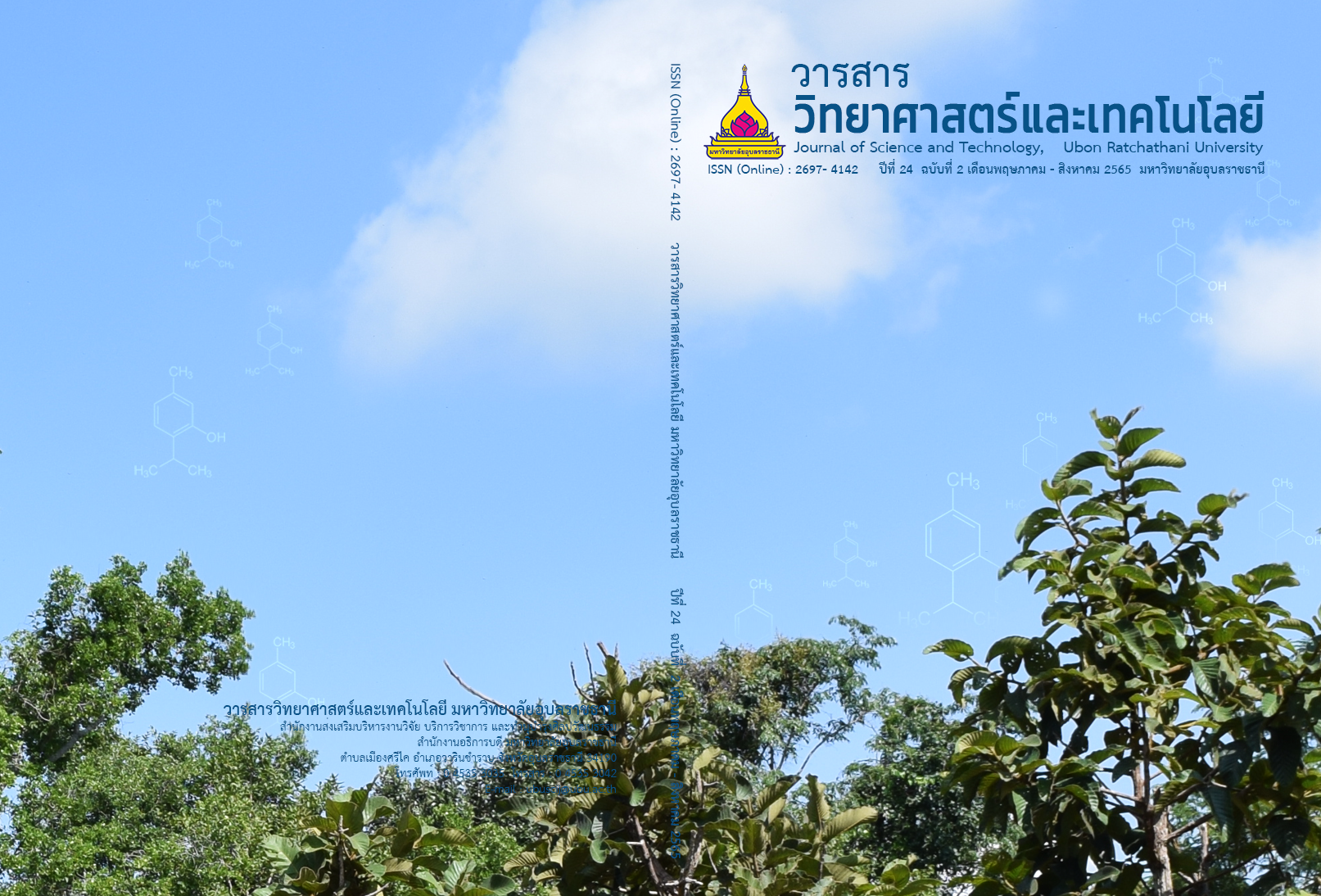ความสามารถและกลไกของไทมอลในการยับยั้งการเจริญของ Listeria monocytogenes
Main Article Content
บทคัดย่อ
Listeria monocytogenes เป็นแบคทีเรียก่อโรคลิสเทอริโอซีส ซึ่งสามารถติดต่อสู่คนโดยการกินอาหารที่มีเชื้อปนเปื้อน ความปลอดภัยและผลกระทบต่อสุขภาพของการใช้สารเคมีถนอมอาหารเพื่อป้องกันการเจริญของจุลินทรีย์ในอาหารยังเป็นสิ่งที่ต้องพิจารณา ดังนั้นในปัจจุบันจึงมีความพยายามที่จะหาสารจากธรรมชาติที่ปลอดภัย เช่น ไทมอล มาใช้แทนสารเคมี การศึกษานี้มีวัตถุประสงค์เพื่อศึกษาความสามารถและกลไกของไทมอลในการยับยั้งการเจริญของ L. monocytogenes จากการใช้วิธี swab paper disc พบว่าไทมอลสามารถยับยั้ง L. monocytogenes และเมื่อใช้วิธี broth dilution assay พบว่า ค่าความเข้มข้นต่ำสุดของไทมอลที่สามารถยับยั้ง L. monocytogenes มีค่าเท่ากับ 1 มิลลิโมลาร์ เมื่อนำเซลล์ของ L. monocytogenes ที่ถูกยับยั้งด้วยไทมอลไปเลี้ยงบนอาหาร BHI พบว่าเซลล์ดังกล่าวไม่สามารถกลับมาเจริญได้อีก แสดงว่าไทมอลมีกลไกการยับยั้งเชื้อแบบทำให้เซลล์ตาย จากการนำเซลล์ของ L. monocytogenes ที่ถูกยับยั้งด้วยไทมอลไปศึกษาด้วยกล้องจุลทรรศน์อิเล็กตรอนแบบส่องกราด พบว่าไทมอลสามารถทำให้เกิดความเสียหายกับผิวเซลล์ ซึ่งสอดคล้องกับการตรวจพบว่าเซลล์ของ L. monocytogenes ที่ถูกยับยั้งด้วยไทมอลมีการรั่วไหลของกรดนิวคลีอิกและโปรตีนออกจากเซลล์ การศึกษานี้แสดงให้เห็นว่าไทมอลมีศักยภาพที่จะนำมาใช้แทนสารเคมีถนอมอาหารเพื่อป้องกันการปนเปื้อนของ L. monocytogenes ในอาหาร
Article Details

อนุญาตภายใต้เงื่อนไข Creative Commons Attribution-NonCommercial-NoDerivatives 4.0 International License.
บทความที่ได้รับการตีพิมพ์เป็นลิขสิทธิ์ของ วารสารวิทยาศาสตร์และเทคโนโลยี มหาวิทยาลัยอุบลราชธานี
ข้อความที่ปรากฏในบทความแต่ละเรื่องในวารสารวิชาการเล่มนี้เป็นความคิดเห็นส่วนตัวของผู้เขียนแต่ละท่านไม่เกี่ยวข้องกับมหาวิทยาลัยอุบลราชธานี และคณาจารย์ท่านอื่นๆในมหาวิทยาลัยฯ แต่อย่างใด ความรับผิดชอบองค์ประกอบทั้งหมดของบทความแต่ละเรื่องเป็นของผู้เขียนแต่ละท่าน หากมีความผิดพลาดใดๆ ผู้เขียนแต่ละท่านจะรับผิดชอบบทความของตนเองแต่ผู้เดียว
เอกสารอ้างอิง
Lopes-Luz, L. and et al. 2021. Listeria monocytogenes: Review of pathogenesis and virulence determinants-targeted immunological assays. Critical Reviews in Microbiology. 47(5): 647-666.
Amit, S.K. and et al. 2017. A review on mechanisms and commercial aspects of food preservation and processing. Agriculture & Food Security. 6: 51.
Campelo, M.C.S., Medeiros, J.M.S. and Silva, J.B.A. 2019. Natural products in food preservation. International Food Research Journal. 26(1): 41-46.
Escobar, A. and et al. 2020. Thymol bioactivity: A review focusing on practical applications. Arabian Journal of Chemistry. 13(12): 9243-9269.
Srisuthum, W. and et al. 2018. Influence of temperature on antimicrobial activity and mode of action of thymol against Escherichia coli O157:H7. Journal of Science and Technology, Ubon Ratchathani University. 20(1): 36-43. (in Thai)
Sepahvand, S. and et al. 2021. Antimicrobial activity of thymol and thymol-nanoemulsion against three food-borne pathogens inoculated in a sausage model. Food and Bioprocess Technology. 14: 1936-1945.
Klein, G., Ruben, C. and Upmann, M. 2013. Antimicrobial activity of essential oil components against potential food spoilage microorganisms. Current Microbiology. 67(2): 200-208.
Marchese, A. and et al. 2016. Antibacterial and antifungal activities of thymol: A brief review of the literature. Food Chemistry. 210: 402-414.
Salehi, B. and et al. 2018. Thymol, thyme, and other plant sources: Health and potential uses. Phytotherapy Research. 32(9): 1688-1706.
Castillo, S. and et al. 2014. The essential oils thymol and carvacrol applied in the packing lines avoid lemon spoilage and maintain quality during storage. Food Control. 35(1): 132-136.
Marino, M., Bersani, C. and Comi, G. 1999. Antimicrobial activity of the essential oils of Thymus vulgaris L. measured using a bioimpedometric method. Journal of Food Protection. 62(9): 1017-1023.
Mith, H. and et al. 2014. Antimicrobial activities of commercial essential oils and their components against food-borne pathogens and food spoilage bacteria. Food Science & Nutrition. 2(4): 403-416.
Walczak, M. and et al. 2021. Potential of carvacrol and thymol in reducing biofilm formation on technical surfaces. Molecules. 26(2723): 1-12.
Thielmann, J., Muranyi, P. and Kazman, P. 2019. Screening essential oils for their antimicrobial activities against the foodborne pathogenic bacteria Escherichia coli and Staphylococcus aureus. Heliyon. 5(6): e01860.
Cai, R. and et al. 2019. Antibacterial activity and mechanism of thymol against Alicyclobacillus acidoterrestris vegetative cells and spores. LWT Food Science and Technology. 105: 377-384.
Trombetta, D. and et al. 2005. Mechanisms of antibacterial action of three monoterpenes. Antimicrobial Agents and Chemotherapy. 49(6): 2474-2478.
Xu, J. and et al. 2008. The antibacterial mechanism of carvacrol and thymol against Escherichia coli. Letters in Applied Microbiology. 47: 147-149.
Wang, L.H. and et al. 2017. Combination of microbiological, spectroscopic and molecular docking techniques to study the antibacterial mechanism of thymol against Staphylococcus aureus: Membrane damage and genomic DNA binding. Analytical and Bioanalytical Chemistry. 409: 1615–1625.
Zhou, W. and et al. 2019. Thymol mediates bactericidal activity against Staphylococcus aureus by targeting an aldo-keto reductase and consequent depletion of NADPH. Journal of Agricultural and Food Chemistry. 67(30): 8382-8392.


